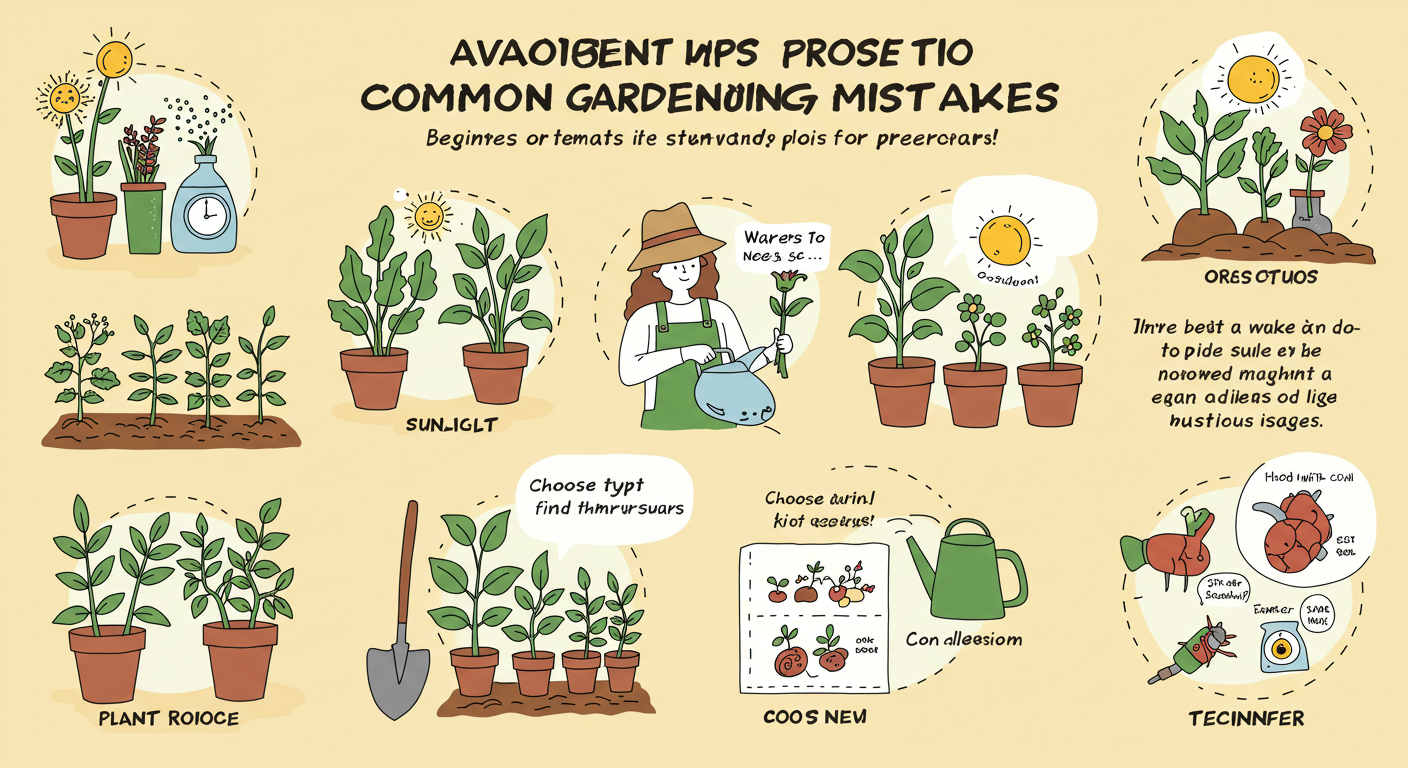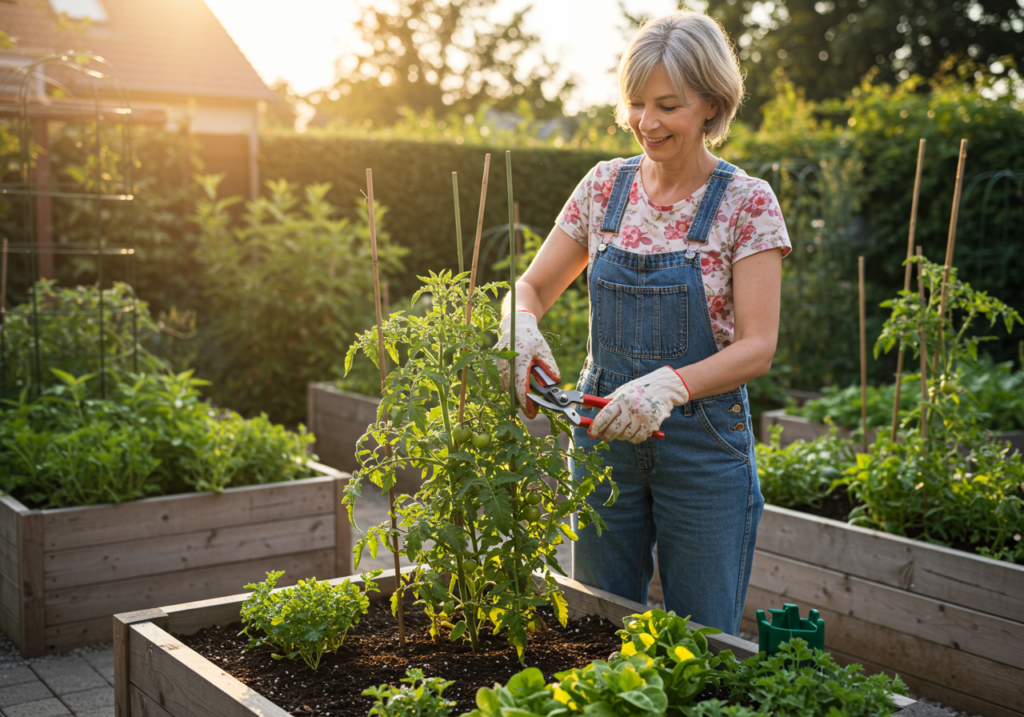Gardening is a rewarding hobby, but even the most enthusiastic beginners can encounter challenges. Don’t be discouraged if your plants aren’t thriving as expected; many new gardeners make similar common gardening mistakes. The good news is that most of these errors are easy to identify and even easier to fix! This guide will walk you through the top six pitfalls and provide straightforward solutions to help you cultivate a flourishing garden with confidence.
Learning from these gardening tips for beginners will not only save your plants but also boost your confidence. Get ready to transform your green space and enjoy the fruits (and flowers!) of your labor.
Top 6 Common Gardening Mistakes and How to Avoid Them Easily
Understanding what can go wrong is the first step toward successful gardening. Let’s delve into the most frequent issues and equip you with the knowledge to prevent them.
1. The Watering Dilemma: Overwatering vs. Underwatering
Watering seems simple, but it’s a critical balance. Both too much and too little water can lead to significant stress for your plants. This is one of the most common plant care mistakes.
#### Overwatering: The Silent Killer
Many new gardeners, in their enthusiasm, give their plants more water than they need. While a drink is good, constant sogginess deprives roots of oxygen, leading to suffocation and root rot. Overwatering symptoms plants often show include:
- Yellowing leaves, especially lower ones.
- Wilting, even though the soil is wet.
- Stunted growth.
- Fungus gnats or mold on the soil surface.
How to avoid it:
- Check the soil: Stick your finger about an inch or two into the soil. If it feels moist, wait. If it’s dry, it’s time to water.
- Proper drainage: Ensure your pots have drainage holes, and garden beds aren’t holding standing water.
- Water deeply but infrequently: Encourage roots to grow deeper by watering thoroughly when needed, rather than small sips daily.

Underwatering: A Thirsty Garden
On the flip side, forgetting to water or providing insufficient amounts can leave your plants parched and struggling. Underwatering signs plants often display include:
- Crispy, brown leaf edges.
- Drooping or wilting leaves that feel dry.
- Slowed or stopped growth.
- Soil pulling away from the sides of the pot.
How to avoid it:
- Consistent schedule: Develop a regular watering schedule based on your plant’s needs, soil type, and weather.
- Mulch: Apply a layer of mulch around plants in garden beds to help retain soil moisture and reduce evaporation.
- Feel the pot: For container plants, a lighter pot often means it’s dry and needs water.
2. Ignoring Soil Health
Think of soil as your plants’ pantry. If the pantry is empty or full of junk food, your plants won’t thrive. Neglecting soil quality is a major beginner gardener mistake to avoid.
Why it matters: Good soil provides essential nutrients, proper drainage, and aeration for healthy root development. Without it, even the best watering routine won’t save your plants.
How to avoid it:
- Start with good soil: Don’t skimp on quality. The best soil for gardening is typically rich in organic matter, well-draining, and provides good aeration.
- Soil testing: Consider a soil test to understand your soil’s pH and nutrient levels.
- Amend with compost: Regularly incorporating compost or other organic matter improves soil structure, fertility, and water retention. This is one of the easiest easy gardening solutions.
3. Improper Plant Spacing
Cramming too many plants into a small space might seem efficient, but it’s a recipe for disaster. Improper plant spacing leads to competition and poor air circulation.
Why it matters:
- Competition: Plants compete for light, water, and nutrients, stunting growth.
- Air circulation: Crowded conditions create humid microclimates, ideal for fungal diseases.
- Yield reduction: Overcrowded vegetable gardens produce smaller harvests.
How to avoid it:
- Read plant tags: Always check the mature size and spacing recommendations on plant labels or seed packets.
- Plan your layout: Before planting, map out where each plant will go, leaving ample room for growth.
- Thin seedlings: Don’t be afraid to remove weaker seedlings to give stronger ones space to flourish.
4. Choosing the Wrong Plants for Your Climate and Conditions
Even experienced gardeners can fall in love with a plant unsuitable for their local environment. This is a common plant care mistake that can lead to constant struggle.
Why it matters: A sun-loving plant won’t thrive in deep shade, and a cold-sensitive plant won’t survive harsh winters without protection. Forcing a plant into the wrong conditions often leads to `Why are my plants dying` scenarios.
How to avoid it:
- Know your zone: Understand your USDA hardiness zone (or local equivalent) to select plants that can tolerate your climate.
- Assess your site: Before choosing right plants for your garden, observe your garden’s light exposure (full sun, partial shade, full shade), soil type, and drainage.
- Research: Look for plants that naturally thrive in conditions similar to yours. Native plants are often an excellent choice.
5. Neglecting Pest and Disease Management
Pests and diseases are an inevitable part of gardening, but ignoring them can quickly devastate your plants. Early detection and intervention are key to preventing garden problems.
Why it matters: A small infestation can quickly multiply, weakening plants, spreading diseases, and even destroying entire crops. You might also notice plant nutrient deficiency symptoms, which can sometimes be exacerbated by pest stress.
How to avoid it:
- Regular inspection: Spend a few minutes each day or week examining your plants for signs of trouble (e.g., chewed leaves, discolored spots, tiny bugs).
- Natural pest control: Encourage beneficial insects that prey on pests. Creating a diverse garden that attracts pollinators like bees and butterflies can also help maintain a balanced ecosystem. Learn more about this here: attracting pollinators create a bee butterfly garden.
- Good hygiene: Remove diseased leaves, sterilize tools, and keep your garden free of debris where pests can hide.
- Organic solutions: Use organic garden pest control natural methods like neem oil or insecticidal soap for targeted issues.
6. Lack of Consistent Care & Planning
Gardening isn’t a one-time activity; it requires ongoing attention. One of the biggest beginner gardener mistakes to avoid is the lack of a consistent approach.
Why it matters: Plants, like any living thing, thrive on routine. Sporadic care (e.g., fertilizing one month, forgetting the next; pruning irregularly) can stress plants and hinder their growth.
How to avoid it:
- Create a schedule: Plan out your gardening tasks – watering, fertilizing, weeding, pruning – on a weekly or monthly basis. This is a vital easy gardening solution.
- Learn basic tasks: Understand the basics of pruning, deadheading, and supporting plants. These gardening tips for beginners are fundamental for `successful gardening tips`.
- Observe and adapt: Your garden is a living system. Pay attention to how your plants react to your care and adjust as needed. Patience and observation are your best tools for how to fix gardening errors.
Conclusion: Your Journey to a Thriving Garden
Every gardener, from novice to expert, has made common gardening mistakes. The key is to learn from them and view them as opportunities for growth. By understanding and avoiding these six frequent errors, you’re well on your way to successful gardening tips and a flourishing outdoor space. Remember, gardening is a continuous learning process. With a little knowledge, observation, and consistent care, you can fix gardening errors and enjoy a beautiful, productive garden for years to come. Happy gardening!
Frequently Asked Questions
What are the main differences between overwatering and underwatering symptoms?
Overwatering deprives roots of oxygen, leading to root rot and yellowing, wilting leaves. Underwatering causes plants to dry out, resulting in crispy, brown leaves and droopy foliage. Always check the soil moisture before watering.
How can I improve my garden’s soil health?
The best soil for gardening is rich in organic matter, well-draining, and offers good aeration. You can improve existing soil by regularly adding compost or other organic amendments.
How do I know the correct spacing for my plants?
Always read plant tags for mature size and spacing recommendations. Plan your garden layout before planting to ensure each plant has enough room to grow without competing for resources or causing overcrowding.
What should I do if my plants are constantly dying despite my best efforts?
Always research plants that are suitable for your local climate zone and your specific garden conditions (sunlight, soil type). Choosing plants that naturally thrive in your environment significantly increases their chances of success.
What are some natural ways to control pests in my garden?
Regularly inspect your plants for early signs of pests or diseases. Implement natural pest control methods like encouraging beneficial insects (e.g., ladybugs) and maintaining good garden hygiene by removing debris and diseased plant parts.





